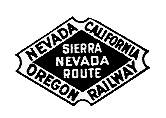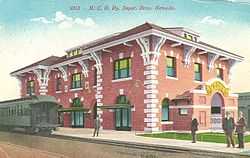Nevada–California–Oregon Railway
| Nevada–California–Oregon Railway | |
|---|---|
 | |
 | |
| Locale | California, Oregon, and Nevada |
| Dates of operation | 1880–1925 |
| Successor | Southern Pacific Company |
| Track gauge | 3 ft (914 mm) |
| Headquarters | Reno, Nevada (1880-1918); Alturas, California (1918-1925) |
The Nevada–California–Oregon Railway was a 3 ft (914 mm) narrow gauge railroad originally planned to connect Reno, Nevada, to the Columbia River. However, only 238 mi (383 km) of track were laid so service never extended beyond Lakeview, Oregon. Because of the company’s reputation for mismanagement, it was often called the "Narrow, Crooked & Ornery" railroad.[1]
History
The railroad was organized in Reno in June 1880 as the Nevada and Oregon Railroad. It was decided that the best plan was to build north to the Columbia River to service cattle ranches and farms in northeastern California and eastern Oregon. The northern terminus was to be The Dalles, Oregon, since that city was located on the Columbia River and had no eastern or southern rail connections at that time.[2]
The company decided to lay 3 ft (914 mm) gauge track because it was cheaper than 4 ft 8 1⁄2 in (1,435 mm) standard gauge construction. Site survey and grading work for the railroad began in December 1880. The first spike was driven in Reno on May 28, 1881.[3] However, the company was short of money so construction was slow. In addition, the board of directors was plagued by corruption and intrigue. One board meeting actually ended with a gun fight between two members. For a period of time, there were two separate boards of directors trying to run the company.[1]
The railroad reached Oneida, California, 30 mi (48 km) north of Reno, on October 2, 1882.[3] Regular service between the two cities began a month later. However, track construction remained slow, and the company’s business problems continued to grow. The Moran Brothers bank in New York was the company’s largest investor. In April 1884, the bank took full control of the railroad, purchasing the company at a court ordered auction for just over $372,000. The company spent the next few years improving existing lines and trying to build up local business.[1]
On January 1, 1893, the name of the railroad was changed to the Nevada–California–Oregon.
The next northward extension commenced in 1899. In April 1902, the line reached Madeline, California. The tracks were extended to Likely, California, in October 1907; Alturas, California, in December 1908; and finally, Lakeview, Oregon, on 10 January 1912.[3] The company planned to continue north through Prineville, Oregon, to The Dalles, with separate branches running west to Klamath Falls and on to the Rogue River Valley, and over the Cascade Mountains to Eugene, Oregon, in the Willamette Valley. However, no further construction ever took place.[1]
Financially, the railroad's best year was 1913, but decline followed quickly.[2] In 1917, the company began selling branch lines in California. The next year, the Reno station was closed, and the company headquarters and maintenance shop were relocated to Alturas. By 1922, the railroad was in serious financial trouble, and the Moran Bank wanted out of the business. On April 30, 1925, the Southern Pacific Company purchased the company. By 1928, Southern Pacific had converted all the remaining Nevada–California–Oregon track to 4 ft 8 1⁄2 in (1,435 mm) standard gauge and sold its 3 ft (914 mm) gauge equipment.[1][3] Several locomotives subsequently ran on the former Carson and Colorado Railroad.[4] One was sold to the Pacific Coast Railway, and later passed to the Oahu Railway and Land Company during World War II.[5] On October 20, 1985, Southern Pacific abandoned the 54.45-mile (87.63 km) section between Lakeview, Oregon and Alturas, California, which is now operated by Lake County Oregon as the Lake County Railroad, running about 20 cars per week in two trips per week. At Alturas it joins with Union Pacific.

Stations
The Nevada–California–Oregon Railroad built classic brick depots in Reno and Lakeview. A smaller stone masonry station was constructed in Alturas.[2] All three passenger depots still exist, and are listed on the United States National Register of Historic Places along with the locomotive house and machine shop in Reno.[6] The N-C-O railway office in Alturas and the depot at Lakeview are examples of the 1880s style of architecture known as Mission Revival. The features include solid massive walls with buttressing, broad unadorned wall surfaces, wide projecting eaves, low-pitched tile roofs,corridors with Roman aqueduct-like arches, terraced bell towers and mission belfry facades. (See The Journal of the Modoc County Historical Society, No. 11, 1989.) The style showed up at Stanford University, the Southern Pacific depot in Santa Barbara and the Mission Inn in Riverside. The architect for the N-C-O buildings was Carl Werner of San Francisco.
- http://www.nps.gov/nr/travel/nevada/nco.htm Architect was not Carl Werner. The photo at right matches the depot designed by a Mr. DeLongchamps.
- http://www.nationalregisterofhistoricplaces.com/ca/Modoc/state.html The Alturas Depot was also not designed by Werner, but built by Martin and Diamond, no architect is listed on the NRHP.
- http://www.nationalregisterofhistoricplaces.com/OR/Lake/state.html Also not Werner, but Frederick DeLongchamps.
Further reading
- Turner, George (1974). Slim Rails through the Sand (3rd edition). Trans-Anglo Books. ISBN 0-87046-016-1.
- Myrick, David. Railroads of Nevada and Eastern California (Vol. 1). Howell-North Books, 1962.
References
- ↑ 1.0 1.1 1.2 1.3 1.4 "Nevada-California-Oregon Railroad", High Desert Rails Railroading in Oregon's Outback (web-site maintained by Jeff Moore), updated as of 15 October 2007.
- ↑ 2.0 2.1 2.2 "N-C-O RY", Gauge on the Net—Old Time Narrow Gauge Railroading, Cedar Ridge, California, 2007.
- ↑ 3.0 3.1 3.2 3.3 Armstrong, Tom, "Nevada-California-Oregon Railway", Slim Rails, 2000.
- ↑ Turner 1974, p.46
- ↑ Chiddix, Jim; Simpson, MacKinnon (2004). Next Stop Honolulu!. Honolulu, Hawaii: Sugar Cane Press. p. 323. ISBN 0-9706213-1-0.
- ↑ National Register of Historic Places, National Park Service, Washington, DC, December 5, 2007.
External links
| Wikimedia Commons has media related to Nevada–California–Oregon Railway. |